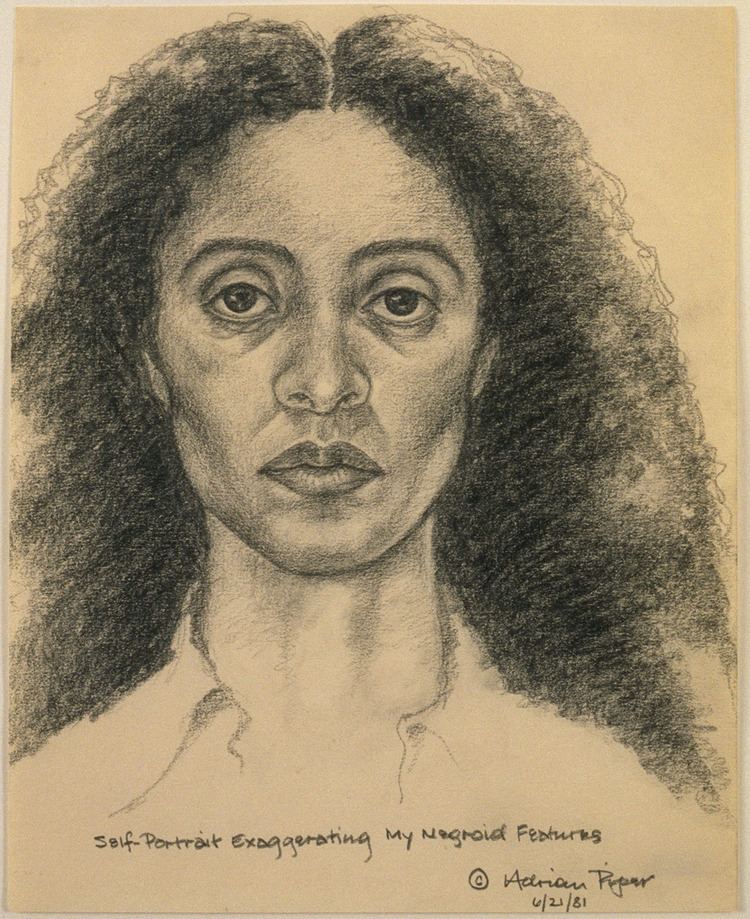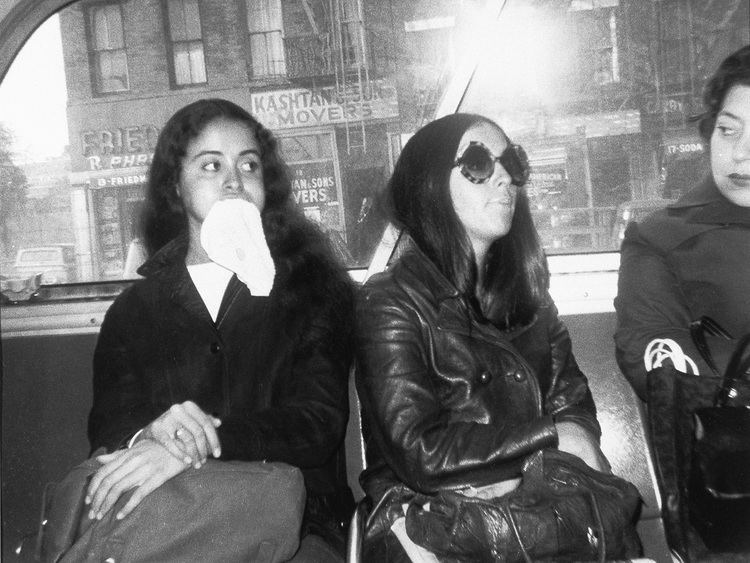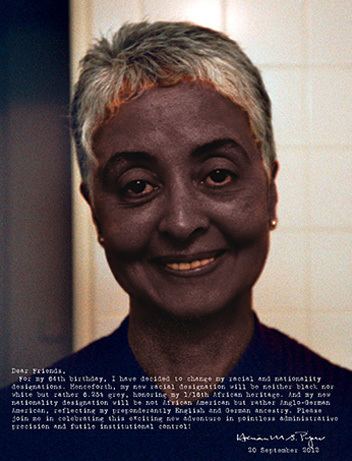Residence Berlin, Germany Period Conceptual art Role Artist | Name Adrian Piper Nationality American | |
 | ||
Education Books Out of Order - Out of Sight, Colored People: A Collabora, Out of Order - Out of Sight, Funkaesthetics, Selected Writings in Art Critici | ||
John p bowles explains adrian piper s work
Adrian Margaret Smith Piper (born September 20, 1948) is an American conceptual artist and philosopher. Her work addresses ostracism, otherness, racial "passing" and racism. She attended the School of Visual Arts, City College of New York, and Harvard University, where she earned her doctorate in 1981. Piper received visual arts fellowships from the National Endowment for the Arts in 1979 and 1982, and a Guggenheim Fellowship in 1989. In 1987, she became the first female African-American philosophy professor to receive academic tenure in the United States. In 2012, she received the Artist Award for Distinguished Body of Work from the College Art Association. In 2015, she was awarded the Golden Lion for best artist of the 2015 Venice Biennale for her participation in Okwui Enwezor’s central show, “All the World’s Futures.”
Contents
- John p bowles explains adrian piper s work
- What will become of me by adrian piper
- Life and career
- Ideology
- Selected works
- Reception
- References

What will become of me by adrian piper
Life and career

Adrian Piper was born on September 20, 1948, in New York City. She was raised in Manhattan in an upper-middle-class black family, and attended a private school with mostly wealthy, white students. She studied art at the School of Visual Arts and graduated with an associate's degree in 1969. Piper then studied philosophy at the City College of New York and graduated with a bachelor's in 1974. Piper received her master's from Harvard University in 1977 and her doctorate in 1981. She also studied at the University of Heidelberg.

Piper was influenced by Sol LeWitt and Yvonne Rainer in the late 60s and early 70s. She worked at the Seth Siegelaub Gallery, known for its conceptual art exhibitions, in 1969. In 1970, she exhibited in the Museum of Modern Art's Information and began to study philosophy in college. Piper has said that she was kicked out of the art world during this time for her race and sex. Her work started to address ostracism, otherness, and attitudes around racism. In Berger's Critique of Pure Racism interview, Piper asserted that while she finds analysis of racism praiseworthy, she wants her artwork to help people confront their racist views.

Piper was awarded visual arts fellowships from the National Endowment for the Arts in 1979 and 1982, and a Guggenheim Fellowship in 1989. Piper taught at Wellesley College, Harvard University, Stanford University, University of Michigan, Georgetown University, and University of California, San Diego. She became the first female African-American philosophy professor to receive academic tenure in the United States in 1991. In 2008, for her refusal to return to the United States while listed as a "Suspicious Traveler" on the U.S. Transportation Security Administration Watch List, Wellesley College terminated her tenured full professorship while she was on unpaid leave in Berlin.

In 2011 the American Philosophical Association awarded her the title of Professor Emeritus. In 2013, the Women's Caucus for Art announced that Piper will be a 2014 recipient of the organization's Lifetime Achievement Award.
Piper is divorced and has no children. She currently lives and works in Berlin, where she runs the Berlin Journal of Philosophy and the Adrian Piper Research Archive. In 2015, she was awarded the Golden Lion for best artist in the international exhibition of the Venice Biennale.
Ideology
In 1981 Piper published an essay titled "Ideology, Confrontation and Political Self-Awareness" in which she discusses concepts she explores through her art. In her essay she contemplates notions of human self-examination and belief structures that serve to "individuate one self from another." These beliefs begin with our early experiences in the world and go unquestioned until they are attacked by new experiences that break the conformity, introducing doubt - the key to self-examination and belief-revision. Piper reveals how the beliefs that we tend to hold onto the longest and often avoid exposing to examination are those that allow us to maintain an understanding that makes sense to us about who we are and how we exist within the world at large. Its pointed out that these ideologies are often responsible for "stupid, insensitive, self-serving [behavior], usually at the expense of other individuals or groups." Piper concludes the essay by telling the reader that if considering the points she brings up makes one self-conscious about their political beliefs in the slightest degree or starts to have even "the slightest glimmerings of doubt about the veracity of [their] opinions, then [she] will consider [the] piece a roaring success."
Selected works
The first mention of Piper as an artist in the printed press was in the Village Voice on March 27, 1969 in response to what is also considered her first solo exhibition, her mail art project Three Untitled Projects. The people and institutions to whom she sent her 8 1/2 × 11 inch stapled booklets that comprised the piece were listed on the last page as the "Exhibit Locations." With this project, Piper succeeded in distributing her work on her own terms to an audience of over 150 artists, curators and dealers of her choosing.
In the 1970s, Piper began a series of street performances under the collective title Catalysis, which included actions such as painting her clothes with white paint and wearing a sign that read "WET PAINT" and going to the Macy's department store to shop for gloves and sunglasses; stuffing a huge white towel into her mouth and riding the bus, subway and Empire State Building Elevator; and dousing herself in a mixture of vinegar, eggs, milk, and cod liver oil and then spending a week moving around New York's subway and bookstores. Catalysis VII involved Piper visiting a museum, chewing gum loudly, and holding a purse full of ketchup. The Catalysis performances were meant to be a catalyst that challenged what constitutes the order of the social field, "at the level of dress, sanity and the distinction between public and private acts." dy. The word "catalysis" describes a chemical reaction caused by a catalytic agent that remains unchanged, and Piper viewed her audience's reaction as the unaffected agent.
Piper's Mythic Being series, started in 1973, saw the artist dress in a wig and mustache and perform publicly as a "third world, working class, overly hostile male."
In 1981, Piper published the essay "Ideology, Confrontation, and Political Self Awareness" in High Performance Magazine. In it, she details three pervasive logical fallacies that she felt contributed to constructing one's ideology: the False Identity Mechanism, Illusion of Perfectability, and One Way Communication Mechanism. She argued that these 3 fallacies lead to the Illusion of Omniscience, which she defined as “[b]eing so convinced of the infallibility of your own beliefs about everyone else that you forget you are perceiving and experiencing as other people from a perspective that is in its own ways just as subjective and limited as theirs.”
Much of Piper's work deals with issues of passing and racism in the United States. For example, her 1986 work Calling Card, is a card that she could give to call out anyone white who made racist comments in public.
Piper's Everything #5.2 (2004) is a piece of mirrored glass shaped like a tombstone that layers the reflection of the viewer, the text "Everything Will Be Taken Away," and the internal structures behind the plaster of the gallery wall. The work can be seen as means of provoking viewers to interrogate the power of institutions to determine the value of a piece of art, as well as to interrogate their own place in the world.
In 2008, Cambridge University Press published her two volume essay "Rationality and the Structure of the Self." Volume I involves a summary of a wealth of Western philosophy, while Volume II focuses on her own interpretation of these philosophers. In Volume II, Piper argues that without moral alienation, we would be unable to forge relationships with others, or act transpersonally in the service of selfless or disinterested moral principles.
In 2013, NYU’s Grey Art Gallery played footage from Piper’s 1973 work Mythic Being in the exhibition, “Radical Presence: Black Performance in Contemporary Art.” Piper rejected this, and requested that the work be removed from the exhibition, as it’s inclusion further underlined the marginalization of minority artists and was in direct opposition to the ideals that she fought to inspire in her viewers.
In The Probable Trust Registry, the piece in which Piper received top honors at the Venice Biennale in 2015, Piper asked visitors to sign contracts with themselves adhering to one of a trio of posted statements (for instance, one read, "I will always do what I say I am going to do."). In a statement accompanying the award, the jury said: "Piper has reformed conceptual practice to include personal subjectivity—of herself, her audience, and the publics in general." They also noted that the piece asks its audience "to engage in a lifelong performance of personal responsibility." In February 2017, the work was central to her first solo exhibition in a German museum at Nationalgalerie at Hamburger Bahnhof.
Reception
Curator Ned Rifkin wrote that Piper "holds a singular position" in the art world. Art critic Michael Brenson described Piper's work as "cut[ting] through the frozen sea in people and lead them into areas of themselves they did not know existed." Piper was included in Peggy Phelan and Helena Reckitt's compendium Art and Feminism (2001) where Phelan wrote that her art "worked to show the ways in which racism and sexism are intertwined pathologies which have distorted our lives."
